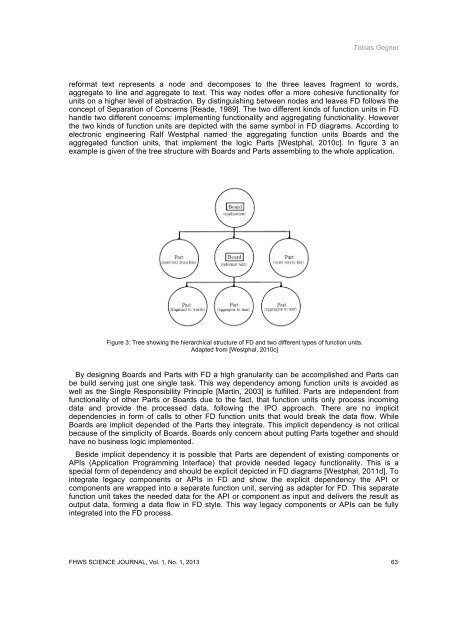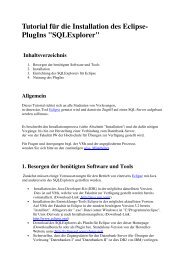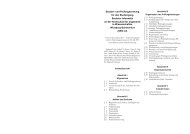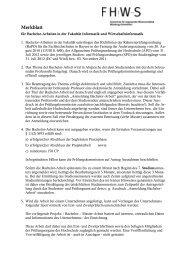FHWS Science Journal - Fakultät Informatik und Wirtschaftsinformatik
FHWS Science Journal - Fakultät Informatik und Wirtschaftsinformatik
FHWS Science Journal - Fakultät Informatik und Wirtschaftsinformatik
Create successful ePaper yourself
Turn your PDF publications into a flip-book with our unique Google optimized e-Paper software.
Tobias Gegner<br />
reformat text represents a node and decomposes to the three leaves fragment to words,<br />
aggregate to line and aggregate to text. This way nodes offer a more cohesive functionality for<br />
units on a higher level of abstraction. By distinguishing between nodes and leaves FD follows the<br />
concept of Separation of Concerns [Reade, 1989]. The two different kinds of function units in FD<br />
handle two different concerns: implementing functionality and aggregating functionality. However<br />
the two kinds of function units are depicted with the same symbol in FD diagrams. According to<br />
electronic engineering Ralf Westphal named the aggregating function units Boards and the<br />
aggregated function units, that implement the logic Parts [Westphal, 2010c]. In figure 3 an<br />
example is given of the tree structure with Boards and Parts assembling to the whole application.<br />
Figure 3: Tree showing the hierarchical structure of FD and two different types of function units.<br />
Adapted from [Westphal, 2010c]<br />
By designing Boards and Parts with FD a high granularity can be accomplished and Parts can<br />
be build serving just one single task. This way dependency among function units is avoided as<br />
well as the Single Responsibility Principle [Martin, 2003] is fulfilled. Parts are independent from<br />
functionality of other Parts or Boards due to the fact, that function units only process incoming<br />
data and provide the processed data, following the IPO approach. There are no implicit<br />
dependencies in form of calls to other FD function units that would break the data flow. While<br />
Boards are implicit depended of the Parts they integrate. This implicit dependency is not critical<br />
because of the simplicity of Boards. Boards only concern about putting Parts together and should<br />
have no business logic implemented.<br />
Beside implicit dependency it is possible that Parts are dependent of existing components or<br />
APIs (Application Programming Interface) that provide needed legacy functionality. This is a<br />
special form of dependency and should be explicit depicted in FD diagrams [Westphal, 2011d]. To<br />
integrate legacy components or APIs in FD and show the explicit dependency the API or<br />
components are wrapped into a separate function unit, serving as adapter for FD. This separate<br />
function unit takes the needed data for the API or component as input and delivers the result as<br />
output data, forming a data flow in FD style. This way legacy components or APIs can be fully<br />
integrated into the FD process.<br />
<strong>FHWS</strong> SCIENCE JOURNAL, Vol. 1, No. 1, 2013 63








